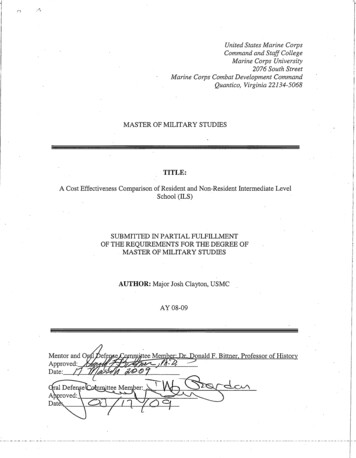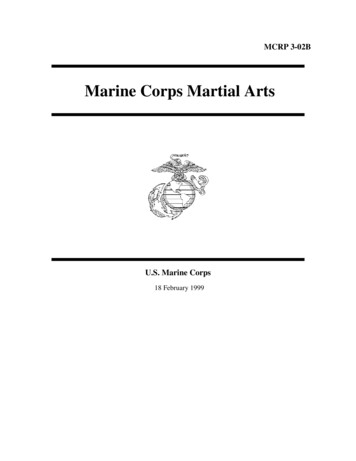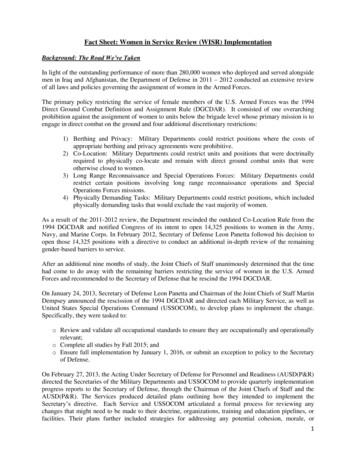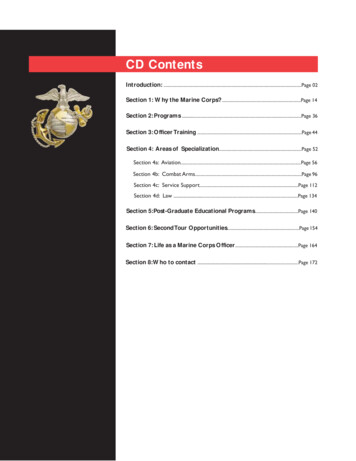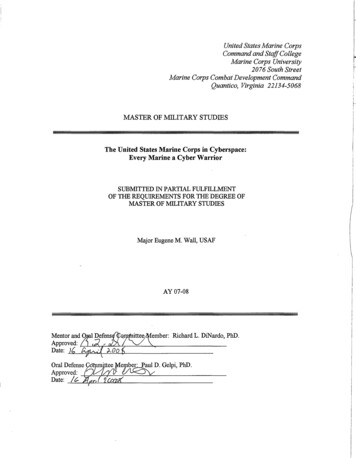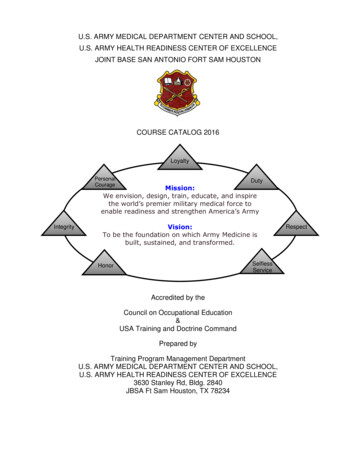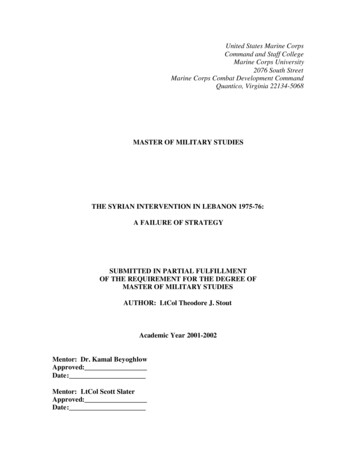
Transcription
United States Marine CorpsCommand and Staff CollegeMarine Corps University2076 South StreetMarine Corps Combat Development CommandQuantico, Virginia 22134-5068MASTER OF MILITARY STUDIESTHE SYRIAN INTERVENTION IN LEBANON 1975-76:A FAILURE OF STRATEGYSUBMITTED IN PARTIAL FULFILLMENTOF THE REQUIREMENT FOR THE DEGREE OFMASTER OF MILITARY STUDIESAUTHOR: LtCol Theodore J. StoutAcademic Year 2001-2002Mentor: Dr. Kamal BeyoghlowApproved:Date:Mentor: LtCol Scott SlaterApproved:Date:
REPORT DOCUMENTATION PAGEForm Approved OMB No.0704-0188Public reporting burder for this collection of information is estibated to average 1 hour per response, including the time for reviewing instructions, searching existing data sources, gathering and maintaining the data needed, and completingand reviewing this collection of information. Send comments regarding this burden estimate or any other aspect of this collection of information, including suggestions for reducing this burder to Department of Defense, WashingtonHeadquarters Services, Directorate for Information Operations and Reports (0704-0188), 1215 Jefferson Davis Highway, Suite 1204, Arlington, VA 22202-4302. Respondents should be aware that notwithstanding any other provision oflaw, no person shall be subject to any penalty for failing to comply with a collection of information if it does not display a currently valid OMB control number. PLEASE DO NOT RETURN YOUR FORM TO THE ABOVE ADDRESS.1. REPORT DATE (DD-MM-YYYY)2. REPORT TYPE01-07-2002Student research paper4. TITLE AND SUBTITLEThe Syrian Intervention in Lebanon 1975-76: A Failure of StrategyUnclassified6. AUTHOR(S)Stout, Theodore J. ;7. PERFORMING ORGANIZATION NAME AND ADDRESSUSMC Command and Staff College2076 South StreetMCCDCQuantico, VA22134-50689. SPONSORING/MONITORING AGENCY NAME AND ADDRESSUSMC Command and Staff College2076 South StreetMCCDCQuantico, VA22134-506812. DISTRIBUTION/AVAILABILITY STATEMENTAPUBLIC RELEASE,13. SUPPLEMENTARY NOTES14. ABSTRACTSee report.15. SUBJECT TERMS16. SECURITY CLASSIFICATION OF:17. LIMITATIONOF ABSTRACTPublic Releasea. REPORTUnclassifiedb. ABSTRACT c. THIS PAGEUnclassifiedUnclassified3. DATES COVERED (FROM - TO)xx-xx-2001 to xx-xx-20025a. CONTRACT NUMBER5b. GRANT NUMBER5c. PROGRAM ELEMENT NUMBER5d. PROJECT NUMBER5e. TASK NUMBER5f. WORK UNIT NUMBER8. PERFORMING ORGANIZATION REPORTNUMBER10. SPONSOR/MONITOR'S ACRONYM(S)11. SPONSOR/MONITOR'S REPORTNUMBER(S)18.19. NAME OF RESPONSIBLE PERSONNUMBER EM114, (blank)OF PAGES lfenster@dtic.mil5619b. TELEPHONE NUMBERInternational Area CodeArea Code Telephone Number703767-9007DSN427-9007Standard Form 298 (Rev. 8-98)Prescribed by ANSI Std Z39.18
DISCLAIMERTHE OPINIONS AND CONCLUSIONS EXPRESSED HEREIN ARE THOSE OF THEINDIVIDUAL STUDENT AUTHOR AND DO NOT NECESSARILY REPRESENTTHE VIEWS OF EITHER THE MARINE CORPS COMMAND AND STAFFCOLLEGE OR ANY OTHER GOVERNMENT AGENCY. REFERENCES TO THISSTUDY SHOULD INCLUDE THE FOREGOING STATEMENT.QUOTATIONS FROM, ABSTRACTION FROM, OR REPRODUCTION OF ALL ORANY PART OF THIS DOCUMENT IS PERMITTED PROVIDED PROPERACKNOWLEDGEMENT IS MADE.ii
EXECUTIVE SUMMARYTitle:The Syrian Intervention in Lebanon: A Failure of StrategyAuthor:LtCol T. J. Stout, United States Marine CorpsThesis:Contrary to conventional wisdom, the Syrian intervention in the LebaneseCivil War of 1975-1976 extended the conflict and caused then President Hafiz al- Assadto fail in achieving his long-term strategic objectives.Discussion: In 1975, Civil War in Lebanon broke out. The following year, 35,000Syrian troops entered the country and remain there today. Syrian President Hafiz alAssad had five strategic goals in Lebanon: (1) Prevention of a radical regime fromgaining power; (2) Securing the Syrian western flank from Israeli invasion; (3)Controlling the Palestinian Liberation Organization; (4) Gaining legitimacy as leader ofpan-Arabism following the death of Egypt’s Gamal Nasser, and; (5) Enhancing theprospect of gaining Lebanon as part of a “Greater Syria.”While initially successful, Assad failed to achieve his long-term goals largely dueto a failure of strategy in Lebanon. During the conflict, the Syrians fought against thePLO. This action against the leaders of the Palestinian resistance movement were widelyunpopular and protested within the Arab states, including Syria. Assad was never able togain control of the PLO, and the outrage among the Arab nations denied him the chanceto ever gain legitimacy as the leader of pan-Arabism. Moreover, the long occupation bySyrian troops led to Israeli intervention and continued violence in Lebanon, preventingAssad from achieving two other strategic goals. At the strategic level, Syria’sintervention failed.Other factors contributed to the failure and are instructive to United Stateswarfighters and warplanners. When placed against the Powell Doctrine, it is evident thatSyrian military actions were at odds with the precepts of the use of military forceexpressed by the former Chairman of the Joint Chiefs of Staff, General Colin Powell.Assad failed to exploit all diplomatic means available to him. He failed to adequatelyweigh risks against gains. He discounted the political costs of military intervention. Andhe failed to apply decisive force once he decided to use military force to achieve hisgoals.Conclusions: The United States today relies too heavily on military force to secure ourstrategic interests. Military force has a limited capability to achieve political goals.When used, it must be used with the other elements of national power. Coalition forcesshould be used whenever possible to add legitimacy to American military actions, and tohelp mitigate the danger of overextending our military forces. Additionally, Americamust look to the future and build a more balanced approach to attaining national goals.The freedom of action enjoyed today as the sole superpower historically has not lastedlong, and we must prepare for a future when military options are not there.iii
CONTENTSDISCLAIMER . iiEXECUTIVE SUMMARY . iiiLIST OF MAPS vChapterPage1. HISTORICAL SETTING 1Introduction . 1Historical Setting . 12. SYRIAN STRATEGIC GOALS 63. OPERATIONAL AND TACTICAL OBJECTIVES . 16Phase I- Transition Phase II- War Phase III- Initial Military Intervention .Phase IV- Full Military Intervention 161820264. FAILURE OF STRATEGY . 305. ASSAD AND THE POWELL DOCTRINE 376. KEY JUDGEMENTS AND CONCLUSIONS 41AppendixesA. The Alawi Religion . 47Bibliography . 49iv
LIST OF MAPSMapsPage1. Lebanon 48v
CHAPTER 1HISTORICAL SETTINGIntroductionIt is a truism that Syria’s intervention in the Lebanese Civil War resulted insending over 40,000 troops into Lebanon between 1975 and 1976. Most of these troopsremain there to this day. While the prevailing thought is that this intervention helped endthe fighting and bloodshed between Lebanon’s recalcitrant sectarian factions, it isincreasingly clear that this came at a high political and military cost for Damascus. Thisessay will argue that contradictory Syrian strategic objectives coupled with a mismatchbetween Syria’s strategic interests and its military operations, and a misapplication ofmilitary force prolonged the conflict in Lebanon, and were in part responsible for thehigh cost of sustaining Syria’s military credibility and guarantee as a peacemaker. Thispaper will develop the above argument by (1) analyzing Syria's strategic, operational, andtactical objectives in Lebanon between 1975-1976, (2) showing how the misapplicationof Syrian military force in Lebanon hindered Damascus's ability to achieve long termstrategic gains, and (3) showing how the Syrian experience in Lebanon could be useful inavoiding similar future pitfalls for US commanders, warfighters, and warplanners.Historical SettingWhen the Lebanese Civil War broke out in 1975, Syrian President Hafiz al- Assadhad been in power for a tumultuous five years, experiencing events both domestically andinternationally that threatened his new regime. While able to remain in power and even1
expand his influence during that period, the constant pressure upon his regime made thePresident fully aware of the need for some stability to consolidate his power and institutehis vision of Syria. Assad’s experiences during his rise to the Presidency and the earlyyears of his reign heavily influenced his vision of Syria, its regional role, and set the stagefor his decision to invade Lebanon. To fully understand his decision, a brief descriptionof the strategic setting from Syria’s domestic and international viewpoint is required.Two main domestic factors were responsible for Assad’s decision to send troopsinto Lebanon: the Ba’th Party and Assad’s Alawi religious affiliation. The Ba’th partyhad consolidated power in the 1960’s with Hafiz Assad as one of the primary powerplayers in the rise of the party. Undergoing internal changes throughout the sixties, bythe time Assad rose to power, the underlying philosophy of the party could be summedup as a socialist, non-sectarian ideology with a pan-Arabic vision. But that very ideologycreated tension in the domestic power bases within the country.With a socialist vision, Ba’th agendas such as land reform and social justice quitenaturally alienated much of the ruling elite. Its appeal was to those groups that felt theywere left behind economically, largely the rural populace. 1 Thus when Assad took powerin a bloodless coup in 1970, he was faced with internal dissention between the old rulingelite in the cities and those largely rural elements of society that had been economicallyless fortunate. Once in power, he strove to reconcile those groups to bring stability to hisregime.1LT Mark A Huber, USN, Legitimacy and Hafez Al-Asad, Naval Postgraduate School Thesis(Monterey, CA: Naval Postgraduate School, June, 1992), 212
Breaking with the harsh socialism of the Ba’thist party of the Sixties, Assad madegreat strides in changing the party to reflect a more centrist view. As author Patrick Sealestates, Assadknew he needed allies in the urban middle class, so, breaking with hispolitical past, he tried to win over the shopkeepers, businessmen, andartisans of the towns as well as the many citzens who had fled Syria since1963, mainly Sunnis from the former leading families. 2By canceling many of the planned land reforms and wooing the middle class, Assadmade strides in consolidating his power.But Assad did not abandon the rural sector nor all of the fundamental ideals ofBa’th party. He instituted many less severe social welfare programs that gained him asolid acceptance amongst many sectors in society. Food prices were cut by 15 percentand responsibility for criminal prosecution was turned over to the police instead of thearmy. 3 Assad also instituted local governmental bodies to provide local outlets forregional disputes. These efforts paid off in keeping dissention under control. But Assad’ssecond domestic crisis would soon appear when a new constitution was proposed.In January 1973, the new constitution was proposed by Assad. The constitutionfailed to stipulate that the President was required to be a Muslim, nor did it stipulateIslam as the national religion. Protests, largely by Sunni Muslims, took place throughoutthe country. Assad gave in to the protests, adding the requirement for the President to bea Muslim, but stood firm against the national religion issue. While this should have beenno major problem, Assad was an Alawi, considered by many Sunni Muslims as a2Patrick Seale, ASAD of Syria: The Struggle for the Middle East (London: I. B. Tauris & Co Ltd,1988), 171.3Seale, 171.3
heterodox form of Islam. 4 If Assad was not a Muslim, he could not be President. Assadasked the Lebanese Shi’i Imam Musa al- Sadr to issue a Fatwa confirming Alawis as aShi’a sect. 5 Although this action averted the immediate crisis, the tension between Alawiand Sunni Muslims would remain an issue.Assad was faced with considerable social and political pressures that tended tomake his regime seem fragile. Above all, his strategic goals would have to be pursuedwith these social tensions and regime survival in mind. Internationally, the strategicsetting has to be viewed with the Syrian domestic tensions in mind.Internationally, by far the most significant events to form Assad’s vision ofSyria’s future were the defeats by the Israelis in 1967 and 1973. Having been deeplyaffected by the humiliating defeat and loss of the Golan Heights in 1967, Hafiz Assadbegan planning for military action to take back the heights and force Israeli concessionsimmediately upon seizing power in 1970. To do so, he needed to rearm and forgealliances against Israel. To rearm, he turned to the Soviet Union where he made severalpersonal trips early in his presidency. 6 Through his diplomacy, he was able to gain thearms necessary to strike at his enemy in the October War of 1973.Among the Arab nations, Assad turned to Egypt’s Anwar Sadat for an ally.Sadat, for his own reasons, agreed to military action against the Israelis, although hisgoals in the conflict were largely at odds with Syria’s, a fact that Sadat kept secret fromhis ally. In short, Sadat’s aims were never to make more than a token show of force,4Seale, 173. For more information on Alawis see appendix A.5Seale, 173.6Seale, 175.4
establishing a beachhead on the Sinai and force Israel to bargain for peace with termssuitable to Egypt’s interests. The resulting defeat of the Arab forces set the stage forAmerican duplicity that served to isolate Syria further. 7Among Syria’s other neighbors, Jordan and Iraq, Assad could not hope for anymilitary partnership with whom to threaten Israel and gain back the territory lost in 1967.Traditional rivals, there was no love lost between Damascus and Baghdad. After the lossin 1973, in fact, the bad blood between Syria and her neighbor increased. To the south,Jordan and Syria formed a bond of necessity, but of no military value. At best, Syriacould only hope that Jordan would provide protection on her south from any Israeliinvasion along that access, but would not be of any offensive help.So on the eve of civil war in Lebanon, Syria found herself isolated militarily,having been betrayed by Sadat, who was moving towards the Sinai II agreement andeventual reconciliation with Israel. Domestically, Assad felt marginally secure, but fullyaware that sectarian feuds, Israeli intervention, or intrigue from Iraq could threaten thesurvival of his regime. With this strategic background, we turn now to Syrian strategicgoals and their relationship to Assad’s decision to intervene in Lebanon.7Seale, 189-20. For more background information see Seale, Chapter 14.5
CHAPTER 2SYRIAN STRATEGIC GOALSIn the United States’ military, warfare is defined at three levels: tactical,operational, and strategic. At the lowest end, the tactical level is primarily the realm ofthe military warfighters. The tactical level of war is defined by battles betweencombatants. As such, it answers the “how” of warfighting. At the next level, theoperational level of war involves the planning of campaigns and actions to supportnational strategic aims. As such, it is primarily the realm of the military warplanners.The operational level of war is critical to tying military actions to a strategic end, andanswers the “what” of warfighting. At the highest level, the strategic level of warinvolves national policy and objectives. It is largely the realm of politicians and policymakers. The strategic level of war is the most critical, for it answers the “why” ofwarfighting, without which tactical and operational actions are without purpose.History is replete with examples of great tactical and operational level successesthat ultimately failed to achieve a strategic goal. The Germans in World War Two weretremendous tacticians and campaign fighters, but strategically failed. They won manygreat victories, yet lost the war in the end due to failed strategy. Likewise, the Americansin the Vietnam War were tremendously successful on the battlefield, yet lost the war.The strategy of building a democratic nation in South Vietnam was arguably notachievable by military force. As will be shown, the Syrians failed in Lebanon due topoor strategy.6
On 13 April, 1975, a bus load of armed Palestinian gunmen was ambushed in theAyn-Rummaneh district of Beirut, killing twenty seven people. This bloodshed sparkedthe civil war that would lead to Syrian military involvement in Lebanon on a scale thatwould not diminish to the present. With an understanding of the internal weakness andmilitary isolation of Syria in 1975, we can look now at the strategic goals that droveAssad to intervene in Lebanon. Hafiz Assad’s had five strategic goals in Lebanon,including: (1) Prevention of a radical regime led by the National Movement from gainingpower in Lebanon; (2) Securing the Syrian western flank from Israeli invasion; (3)Controlling the Palestinian Liberation Organization (PLO); (4) Gaining legitimacy as theleader of pan-Arabism following the death of Nasser, and; (5) Enhancing the prospect ofa “Greater Syria.”As has already been shown, many within his country did not fully accept Assad’sAlawi regime. His power base was strong, but narrowly focused. 8 Strong support forAssad existed in the army, which was his strategic center of gravity, and among the ruralpopulation that benefited most from the Ba’th policies. But Assad faced opposition fromsome of the old ruling Sunni elite who had lost the most power since the rise of the Ba’thParty. Additionally, among many conservative Muslems, the Alawis remained outside ofthe Islamic world. Radical groups like the Moslem Brotherhood found Assad’s Alawireligion ripe grounds for dissention. 98CDR John C. Burch, USN, BackGround Issues Concerning Soviet Foreign Policy and SyrianInitiatives in the Middle East, Naval Post Graduate Thesis, (Monterey, CA: Naval PostGraduate School,March 1986), 29.9Seale, 178.7
With internal weaknesses at home, and feeling isolated at large, the eruption ofviolence in Lebanon posed a threat to Hafiz Assad that could not be ignored. Syria andLebanon enjoyed a symbiotic relationship, not surprising since Lebanon had beensplintered from Syria under the French Mandate. The ties between the countries wereindisputable. As Patrick Seale states, “The two countries were like connecting vessels:the political temperature of the one could not but affect that of the other.”10 Thus,violence in one country affected the other. When the radical National Movement, backedby PLO forces began to seriously threaten the stability of Lebanon, Assad had to act forstability at home. He could not afford a radical movement along his borders that couldspillover into Syria.The second strategic goal was securing Syria’s western flank against Israeliinvasion. In 1973, the Israeli’s had come within 25 miles of Damascus, a lesson not soonforgotten. Southern Lebanon provided a route for Israel to flank existing Syriandefensive forces arrayed against Israeli positions on the Golan Heights. The BekaaValley in particular provided a dangerous avenue of approach should Israel decide toonce again conduct offensive actions against Syria (See Map 1). The possibility ofpermanently closing off that route was a major consideration for Assad.Assad faced another quandary. As the fighting in Lebanon increased and theChristians began to be hard pressed by the PLO and National Movement, the specter ofIsraeli intervention in Lebanon became stronger. He could not possibly sit by and donothing if Israel invaded Lebanon for fear of the reaction at home. Yet he was not10Seale, 269.8
militarily strong enough to take on the Israelis alone. Assad had to preempt Israeliaction, or suffer the prospect of losing power.Syria’s third strategic objective, was to gain control over the PLO in Lebanon.Syria’s relations with the PLO had been mixed since Yasser Arafat’s rise to prominence.While ardent supporters of the Palestinian cause, Syria saw their cause as linked to that ofthe Arab people, not strictly the Palestinians. From 1964-1966, Palestinian units,supported and led by Syrians, operated against Israel, often using the Golan area as aninfiltration point. But the Syrians closely controlled the military operations and Arafathad chafed under the tight controls placed on his group.Yasser Arafat saw the Palestinian cause as one of the Palestinian people. 11 Whilehe needed Arab support, he desired to lead the effort to regain Palestine unfettered by anyauthority, feeling it was up to the Palestinians to achieve their objectives on terms of theirown choosing. If he allowed other nations to dictate the conditions upon which the PLOwere to operate, the objectives of the PLO would be in danger of being subordinate to thestrategic objectives of the sponsoring state, as it had been earlier while operating fromJordan and Syria.While in Syria, Arafat had conducted unsanctioned operations, earning him thewrath of Hafiz Assad, then Minister of Defense and responsible for all military actions.In May 1966, the leader of the PLF was found murdered and Assad, suspecting Arafat,threw him in jail for 55 days. Arafat was finally released on the terms that he wouldnever return. 12 Thus, Arafat and Assad had historical differences, and when the PLO were11Ghada H. Talhami, Syria and the Palestinians (Gainesville, FL: University Press of Florida,2001), 149.12Talhami ,, 85-87.9
later evicted from Jordan after trying to overthrow the government, they moved theiroperating base to Beirut instead of Damascus in the hopes of operating independent ofstate sponsorship. This very independence could threaten Syria’s own long-termobjectives regarding Israel. If Arafat decided to make peace with the Israelis on his ownterms, Syria could not tie that peace to his own objective of regaining the Golan Heights.Consequently, Assad desired to reign in an independent PLO.Another reason for Assad’s desire to gain control of the PLO was thedestabilizing influence they were having in Lebanon. Uncontrolled operations againstIsrael were being answered by increasingly violent retaliatory strikes in Lebanon.Between 1968-1974, the Israelis conducted forty-four major retaliatory strikes againstPLO positions in Lebanon. 13 Assad was convinced that the Israeli’s were using the PLOincursions as a reason to fragment the Lebanese society. Palestinian actions and theLebanese Army’s inability to stop them was increasingly driving a wedge between theChristians, who thought they should be punished, and the Muslims, who thought the PLOshould be protected. As Seale statesIf the Christians were driven by Palestinian and Muslim pressure to set upa sectarian statelet of their own, Arab nationalism would be discredited,Islam would be made to seem intolerant, the Palestinian program for a‘secular democratic state’ embracing Muslims, Christians and Jews wouldappear hollow, and Israel would reign supreme over the balkanizedLevant. 14In fact, the prospect of a Christian drive for a separate mini-state was very real.By late 1975, the primary Christian leaders, Camille Chamoun, Suleiman Faranjiyaa, andBashir Jumayyil, began to talk openly about the possibility of a Christian retraction to the13Seale, 275.14Seale, 275.10
pre-1920 boundaries centered on Mount Lebanon. Increased Palestinian support of theNational Movement convinced the Phalangists that a return to status quo wasunattainable without foreign intervention. 15 Whether it was political rhetoric or a truedesire upon the part of the Christians to create an autonomous canton within Lebanon, toSyria, the prospect of a separate, pro-Western entity in Lebanon was patentlyunacceptable. In Assad’s eyes, it would create a “Maronite Zion” in the middle of thecountry. 16 PLO involvement in the conflict was therefore upsetting the precarious balancein Lebanon, creating potential problems for Syria. To meet his own goals, then, Assadneeded to gain control of the PLO.Assad’s fourth strategic objective was to gain prominence as the new leader ofpan-Arabism. As a cornerstone of the Ba’th platform, pan- Arabism was a secular idealthat crossed sectarian lines. Between 1958-1961, Syria had joined with Egypt to form theshort-lived United Arab Republic. 17 Led by the pan-Arabic ideals of Gamal AbdulNasser, Assad had served in Egypt during the UAR period and was heavily influenced byhis experience there. But Nasser had died in 1970, and pan- Arabism remained without astrong central figure. Assad considered Syria the natural successor to the pan-Arabicmovement, and frequently used the pan-Arabic message in news releases and speeches. 1815Rabinovich, 47.16Itamar Rabinovich, The War for Lebanon 1970-1983 (Ithaca, NY: Cornell University Press,1984) 47.17Talhami , 57-58.18Huber, 31-39. Huber quotes several press releases that signify the use of pan-Arabism as a centraltheme.11
In his thesis written at the Naval Postgraduate School, LT Mark Huber, USN, 19makes a convincing argument that Assad’s support of pan-Arabic ideals wasdisingenuous. His thesis is that pan- Arabism was only a tool used by Assad to addlegitimacy to his regime. He points out the fact that Syria backed non-Arab Iran againstArab Iraq in their eight-year war. Whether his thesis is correct or not is largely irrelevant.The fact is that Assad wanted to be viewed as the leader of pan- Arabism whether hiscommitment to its ideals was real or not. In his landmark radio speech to the Syrianpeople on July 20, 1976, Assad statedOn our position on Lebanon, we proceed from the fact that we are sons ofa single Arab nation. What prompts us to show serious concern towardwhat is happening in Lebanon is our anxiety over the tragedies there. Weare concerned about all Lebanese---Christians and Moslems---becausethey are the sons of our Arab nation and come under the flag of Arabnationalism. 20In regards to Lebanon, Assad clearly used the pan-Arabic argument to justify his actionsthere, whether his beliefs were genuine or not.Assad’s final, and perhaps most debatable, strategic goal was the possibility ofgaining control over Lebanon and bringing back a splintered province of “Greater Syria”into the fold. Up until 1975, Syria had been unable to concentrate efforts on gainingback territory severed by the French, although they had influenced events in Lebanon to acertain degree. The instability at home, frequent coups, and continued tensions withIsrael all tended to delay any serious efforts to incorporate Lebanon. Ever theopportunist, Assad saw a possibility growing as events unfolded in the neighboringconflict.19Huber, 31-39.20Rabinovich, 215.12
That Syria saw Lebanon and Palestine as an integral part of her is hard to dispute.Pertaining to Palestine, Assad told Yasser ArafatYou do not represent Palestine as much as we do. Do not forget one thing:there is no Palestinian people, no Palestinian entity, there is only Syria!You are an integral part of the Syrian people and Palestine is an integralpart of Syria. Therefore it is we, the Syrian authorities, who are the realrepresentatives of the Palestinian people. 21This statement unveils Assad’s view of a “Greater Syria.” In Lebanon, the feelings ofunity went even deeper.Despite three agreements to the contrary, Syria has yet to remove its militaryoccupation force from Lebanon. The continued Syrian presence has affected virtuallyevery facet of Lebanese life. In the words of international lawyer and human rightsadvocate Muhammed Mugraby,Official Syrian holidays, such as the one commemorating Assad’s“Correctional Movement,” are celebrated in Lebanon as in Syria. Picturesof Hafiz al Assad and his sons greet passengers at the Beirut airportmuch as they do at the Damascus airport. Lebanese newspapers andmedia carry no criticism of Syrian policies, either explicitly or implicitly. 22Moreover, the influx of hundreds of thousands of Syrian workers in Lebanon, who areallowed to settle there and sometimes bring family members, has contributed to a steadyremaking of Lebanon into a lesser Syrian state. 23 This view of Lebanon as part of Syria isreflected in political rhetoric from Damascus, which has “ made innumerable claims toLebanon and uses such terms as 'brotherly’ relations between two ‘statelets.’2421Huber, 42.22Muhammed Mugraby, “Lebanon, a Wholly Owned Subsidiary,” Middle East Quarterly, March1998, 12.23Daniel Pipes, “We Don’t Need Syria in Lebanon, ” Middle East Quarterly, September 2000, 21-23.24Habib C. Malik, “Is There Still a Lebanon?” Middle East Quarterly, December, 1997, 18.13
Beyond the social changes resulting from Syria’s involvement in Lebanon, theLebanese government is totally subservient to Syria. Politicians from Beirut travelfrequently to Damascus to “consult” with the Syrian leadership. Syrian backed politicalcandidates are elected, sometimes through outright fraud. One example of this politicalinterference on the part of the Syrians was the declaration by the Lebanese parliament ofRafiq al- Harari as the Prime Minister in 1998. Harari, Syria’s choice, had renounced hisLebanese citizenship and lived in Saudi Arabia. Consequently, he had no politicalcredentials as a legitimate Lebanese candidate. Yet Syrian influence ensured hiselection. 25Finally, Syria has moved to economically tie the two countries closer than ever.Lebanon was forced to convert their power stations to liquefied natural gas, which isprovided by Syria. Common power grids and roads have been forced on the Lebanesepeople, tying the two countries together. 26 Construction contracts are given to companieschosen by the Syrian proxies in Beirut, 27 and ma
Author: LtCol T. J. Stout, United States Marine Corps Thesis: Contrary to conventional wisdom, the Syrian intervention in the Lebanese Civil War of 1975-1976 extended the conflict and caused then President Hafiz al-Assad to fail in achieving his long-term strategic objectives. Discussion: In 1975, Civil War in Lebanon broke out. The following .

